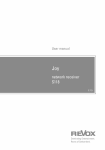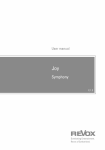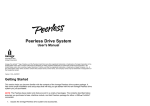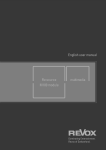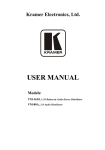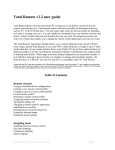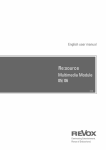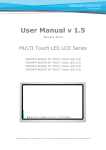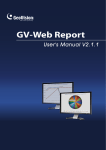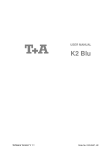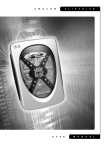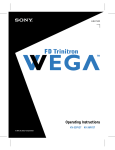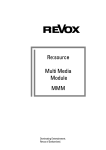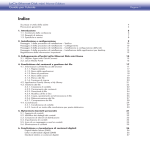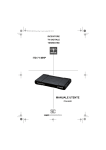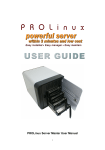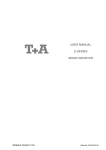Download M200 - Interface
Transcript
Introduction
network receiver
E 1.1
1
Contents
network receiver
Welcome .................................................... 3
S208 Basic settings ................................. 17
Setup ............................................................. 4
Scope of delivery .......................................... 4
Safety ............................................................ 4
Caution: Lithium batteries (internal) ............ 4
Installation - Safety advice .......................... 5
Safety measures ........................................... 6
Regulations pertaining to the unit................ 7
Fuse ............................................................... 7
S119/ S120 Front panel ................................. 8
Display colours: Status LED ......................... 9
S119/ S120 Connection panel ..................... 10
Explanation of the connections ................. 11
Remote control ............................. 17
Select device ................................ 19
Change zone ................................. 19
Information ................................... 19
Start Pairing.................................. 20
First contact................................................ 21
Speakers and outputs ......................... 21
Power cable ......................................... 21
LAN/WLAN network connection ....... 21
Establishing the connection to the network
.................................................................... 22
Establishing the connection to the remote
control using pairing .................................. 23
Establishing the connection to the remote
control ......................................................... 24
S208 Remote control ............................... 12
Initial operation........................................... 12
One S208 controls several receivers 12
Two S208s for one receiver ................ 12
Lithium battery information................. 12
S208 Overview ............................................ 13
Explanation of the Remote control ............ 14
Charging the battery ................................... 15
Charging control / status display ....... 15
Battery care ................................................ 16
Keep the number of charging cycles to
a minimum ............................................. 16
Store in a cool environment ............... 16
Total discharge protection ................. 16
Useful facts: Revox Joy radio system........ 16
First steps in the Main menu
............ 25
Radio not available!? ................................. 26
S119/S120 Basic settings ........................... 27
Speaker Setup .............................. 28
Network ................................. 30
Network Status .................................... 30
WLAN status ........................................ 30
IP Settings ............................................ 30
WLAN Settings..................................... 31
Network Restart................................... 31
MAC Address ....................................... 31
Quick start function ............................. 31
Software ....................................... 32
Internet.................................................. 32
USB........................................................ 32
Remote access ............................. 33
Clock ............................................. 33
Auto Standby ................................ 34
Operation - Start-up process ................. 35
The configuration options .......................... 36
Operation .................................................... 37
1
network receiver
Main menu ............................................... 38
Last Music .................................................. 38
My Music.................................................... 39
Shortening access times .................... 40
Radio ........................................................... 41
USB/ iPod ................................................. 45
USB ........................................................ 45
iPod ...................................................... 45
iPod selection..................................... 46
Music server .............................................. 47
Control functions........................................ 48
Cover display ........................................ 48
Local inputs ................................................ 49
Rename Input ....................................... 50
Settings and comfort functions ................. 51
Sound Setting ............................... 51
Alarm Clock 1 / 2 .......................... 52
Short Time Alarm ......................... 54
Sleep-Ttimer................................. 55
Change My Music ........................ 55
Device info ................................... 57
Basic settings .............................. 57
Setting up Internet Radio ....................... 58
Internet Audio Portal - IAP .................... 59
Initial login .................................................. 60
IAP Registration page ................................ 61
Managing the Revox IAP ........................... 62
Adding radio stations to Favorits .............. 63
Contents
Error messages ....................................... 64
Status messages ..................................... 67
A.
Switching the device on ......... 67
B.
Waiting for the network .......... 67
C.
Switching the device off ......... 67
Network terminology ............................ 68
General .................................................. 68
DNS ....................................................... 68
LAN ........................................................ 68
Gateway ................................................ 68
Client...................................................... 69
DHCP ..................................................... 69
IP Address ............................................ 69
MAC Address ....................................... 69
NAS ....................................................... 69
Power Line – LAN ................................ 69
Proxy Server ......................................... 69
Router (WLAN Router) ........................ 70
Server .................................................... 70
SSID ....................................................... 70
UPnP-AV ............................................... 70
WLAN .................................................... 71
WPA....................................................... 71
WEP ....................................................... 71
Wi-Fi ...................................................... 71
Network: Questions & Answers ............ 72
Appendix .................................................. 75
Warranty ..................................................... 75
Copyright advice ......................................... 75
Environmental protection ........................... 75
Technical data S119/ S120 ......................... 76
2
Introduction
network receiver
Welcome
The S119 and S120 network receivers
from Revox combine the latest streaming
technology with an audiophile stereo
output from the high-end range.
When you see the compact construction, it
is easy to forget that there are full-blown
torodial transformers and heavy duty
power supplies at work in the network
receivers, so that if required, up to 240
watts (S120) are available at the speaker
terminals. Combined with the DSP
professional speakers and space
correction, you, in the company of your
Revox speakers, will reach a musical
zenith, which need fear no comparison
with its peers.
In order to keep the operation on a par
with the sophisticated technology, a lot
of time and effort was invested in the
detail of the optional remote control. You
will feel it and see it.
This product innovation from Revox
stands out as a true system for life,
thanks to its legendary robustness and
longevity, which the brand is known for
throughout the world.
For the benefit of audiophile music
lovers, Revox deliberately avoided the
use of fans. So that nonetheless, the
S119/S120 can keep a cool head, even
when the temperatures outside top the
40°C mark, a heat coupler has been
used. This aluminium heat pipe
dissipates the heat away from the
network processor over a gold-plated
coating on a large area of copper. The
heat can then escape from the inside of
the housing through the convection
openings. In this way, we achieve a
processor temperature that is lower by
up to 30°C, which impacts positively on
the processor stability and ensures a
long working life.
3
network receiver
Setup
Safety
Please check the unit and accessories
after unpacking, to ensure that
everything is there and that there are no
signs of transit damage. Read the User
manual through carefully before starting
to use the unit. Keep the manual for later
reference.
Take note of the label on the back of the
unit.
A unit that shows signs of mechanical
damage or which has had liquid in it
should not be connected to the mains
supply.
In order to avoid the risk of an electric
shock, do not open the housing.
Maintenance and repairs should only be
carried out by qualified experts.
Only use the mains cable supplied. The
unit’s power supply and connections
values (mains voltage, frequency) must
be checked before connecting it to the
mains. Fuses used in the device must
comply with the factory definitions in the
“Technical Data” section.
Scope of delivery
Network receiver (1x)
Power cable (1x)
Network cable (1x)
Quick Reference Guide
network receiver User manual CD *
* Contains the complete S119/S120 German/English
User manual in PDF format. A PDF Reader is required.
4
Introduction
Caution: Lithium batteries (internal)
Danger of explosion if battery is
incorrectly replaced. Replace only with
the same or equivalent type – CR2032
3V.
Batteries shall not be exposed to
excessive heat such as sunshine, fire
or the like.
Take note of the disposal hints within
the chapter Appendix.
Introduction
network receiver
Installation - Safety advice
Please follow the instructions in the
User manual supplied.
Do not position the unit close to strong
heat sources or in direct sunlight.
Please take note of the following, if the
receiver is to be installed in a cabinet
or closed shelves. Allow at least 5 cm
of free space around the device, so
that the air can circulate freely and
that there is no build up of heat. Do not
cover openings on the back wall or in
the base of the unit.
It must be ensured that the correction
functioning of the unit's ventilation
openings is not affected by being
covered, e.g. by curtains, newspapers,
table cloths, or similar.
This unit conforms to protection class
2. This means that with this unit, the
ground cable is not connected to the
housing, in order to effectively
eliminate sound-damaging groundloops. With these network receivers
however, Revox uses the ground cable
for the reduction of noise fields. For
this reason, both the supplied cable
and the connection panel are fitted
with a ground cable.
The power plug should be removed
from the socket during longer periods
of non-use, for instance during an
absence.
Unplug the unit from the mains during
storms. Voltage peaks through the
mains power supply caused by
lightning strikes can damage the unit.
There must be easy access to the
power plug so that the unit can be
unplugged at all times.
Lay the power cable such that it
cannot be damaged. The power cable
should not have kinks or be laid over
sharp edges. It should not be walked
on or be exposed to any chemicals.
The last point is valid for the whole
unit. A power cable with damaged
insulation can lead to electric shocks
and represents a fire hazard.
Never pull on the cable when plugging
the unit in or out. Always hold the plug.
Liquids, flammable or other objects
should not be inserted in the unit’s
openings as this can lead to faults, fire
or an electrical shock.
Do not expose the device to splash
water or high levels of humidity. Do not
stand containers filled with liquid, e.g.
flower vases, on the device.
It is only designed for operation in
temperate, non-tropical climates.
Take note of and follow the safety
advice on the following pages.
5
network receiver
Introduction
Safety measures
Read and take note of the following
safety advice for your own safety and to
avoid unnecessary damage to your
equipment. Please keep this safety
advice in a safe place for future
reference.
Avoid locating the unit in a position
which:
- is exposed to direct sunlight
- is directly next to a source of heat
- has poor ventilation
- has a dusty atmosphere
- is unstable
- has high humidity
The guarantee covers the intended
usage of the unit.
High build-ups of dust and humidity
cause creepage current in the unit that
can cause a risk of shocks when
touching the unit or lead to a fire.
If you have moved the unit from a cold to
a warm environment, leave it switched
off for about two hours because of a
possible build up of condensation
dampness.
You should always switch your S119/
S120 off before connecting or
disconnecting
other
devices
or
speakers.
Protect your unit from:
- damp, dripping water and steam
- impacts and mechanical loads
- magnetic and electrical fields
- cold, heat, direct rays of the sun and
severe changes of temperature.
- dust
- accesses to the inside of the device
Do not stand any articles with open
flames, e.g. lit candles on the unit.
Please note
In order to exclude the risk of an electric
shock, do not remove the housing. Only
have repair work carried out by a Revox
specialist dealer.
Volume
Loud music can cause hearing damage.
Avoid extremes of volume, particularly
over longer periods of time.
Supervision
Do not allow children to handle the
equipment without supervision. Do not
allow children in close proximity to the
unit. Do not operate the S119/S120
without supervision. Switch the power
switch off or unplug the unit if you are
going to be absent for a longer period of
time.
Cleaning
The unit should be cleaned using just a
damp, soft and clean cloth without any
abrasive cleaning agents.
6
Introduction
network receiver
Regulations pertaining to the unit
In EU and EEC countries, Revox offers a
guarantee on units bought in the EU,
over and above the statutory rights of
guarantee claims against the seller. The
guarantee covers material and labour
during the period of the guarantee,
which is defined by the Revox Sales
Partners in the individual countries that
make up the EU.
In all countries, the guarantee services
offered by the Revox Sales Agents are
over and above the statutory regulations.
They are only valid in the country of
purchase. Proof of purchase from an
authorised Revox Partner must be
produced to make a claim on the
guarantee.
The guarantee is made null and void in
the case of incorrect intervention
measures or non-professionally executed
repairs.
Fuse
The S119/S120 is equipped with a
primary fuse located inside the housing.
This internal fuse may not be changed by
the user.
In this case of a fault, please contact
your nearest Revox Service Point.
7
network receiver
Presentation
S119/ S120 Front panel
As well as housing the multi-colour
status LED, the front panel of the
receiver also conceals a radio module
(RF) for the bidirectional data traffic with
the optional S208 remote control. The
unit is controlled through the S208
remote control.
Front view of the S119 network receiver
8
Advice about the installation location
As the radio module is located directly
behind the glass panel on the front of the
unit, the S119/S120 should be installed so
that it is aligned in the direction of the
remote control. This guarantees the
maximum distance for operating use the
S208. Walls and ceilings, particularly
those made out of brick or concrete
(with
reinforcement),
significantly
reduce the distance.
Presentation
network receiver
Display colours: Status LED
Dark-blue
Quickstart function [off]:
In this standby mode, all functions,
with the exception of the radio
module, are deactivated.
Power consumption: < 0.6 W*
Light-blue
Quickstart function [on]:
Unit is in standby mode. If the
Quickstart function is activated, the
network processor is switched on
permanently. This significantly reduces
the switch-on phase, as the
connection to the network doesn't
have to be built up again. All other
sub-assemblies, such as the audio
signal processing or the outputs,
including the main transformer are
switched off, as with normal standby
mode. Quickstart mode is also a
requirement, in order to be able to
control the receiver with a networkbased Revox App.
Power consumption: approx. 4.5 W*
The USB input supports the charging of
external devices, e.g. an iPhone in
standby mode.
Green (flashing)
After switching on at the power switch,
the status LED flashes green for about 10
seconds. During this time, the S208 remote
control can be paired/ synchronised with
the receiver, i.e. these two devices can be
connected with each other, functionally.
You will find the necessary steps for this
procedure explained in the S208 Remote
control chapter.
Red (flashing)
A non-defined fault has occurred. If
necessary, switch the unit off and on
using the power switch.
Red (permanent)
The timer in the network receiver is
active. This can be the case, for example,
if the timer function is activated, with
which the receiver switches itself on
automatically after a certain time.
White
The receiver is in operation.
* without USB feed
.
9
network receiver
S119/ S120 Connection panel
Please take note of the
connection information on
the following pages.
10
Presentation
Presentation
network receiver
Explanation of the connections
Name
Function
AC Power
Power cable connection (class 2 with ground cable) The
voltage definition [V~] on the unit label must be adhered to.
Aux 1 / Aux 2
Analogue audio inputs, max. input voltage: 2.0 V pp
Coax 1 / Coax 2
Digital audio inputs through coaxial cable
Optional1
Antenna input for an optional FM/DAB module
Factory2
Reset button for restoring factory defaults. Can be activated
using a paper clip.
Loudspeaker (Right + Left)
Speaker connection / Impedance: at least 4Ω
Network
Power switch
RJ45 network connection for wired audio streaming (iRadio,
NAS) and for App control
Power switch - no power consumption when in off position
Please note: If the power cable is connected, certain internal
switching areas are live, even if the switch is in the off position.
Optical 1/ Optical 2
Digital audio inputs through fibre optic - TOSLink
Output Analog
Controlled analogue audio output, e.g. for external output
Output Digital
Digital audio output over coaxial cable (potential-free)
Output Sub (Subwoofer)
Start up
USB
Wi-Fi
1
2
Controlled analogue audio output for active subwoofer
Pilot signal for subwoofer wakeup available in the S119/S120
basic settings
Start button for start-up from the standby state. Quick Start
function is activated for permanent control through an App.
USB B input for the USB data carriers or iPod/iPhone
connection.
WLAN antenna connection for wireless audio streaming
(iRadio, NAS) and App control, supplied with the unit
not supplied with the S119/S120
Switch off the S119/ S120 via Power switch – keep pressing the Factory button –
Switch on the device via Power switch. When the status LED (front) starts flashing green,
release the Factory button.
11
network receiver
Presentation
S208 Remote control
The optional S208 Remote control offers
you the optimum way to control the
S119/S120
network
receiver.
All
information is displayed clearly on the
TFT colour display, through the bidirectional
wireless
connection.
Additionally, the control of third-party
devices with an IR Code can be
integrated through a database. The
remote control is configured using the
free-of-charge S208 EasyCreator PC
software that can be downloaded from
the Revox homepage.
Initial operation
The remote control battery should be
charged up for at least 3 hours before
you start to use it. Please refer to Page
15 of this User manual for information on
how to do this.
The charger supplied with the remote
control is used to charge the lithium ion
battery in the S208.
The operation of the S119/S120 using the
S208 Remote control is described in the
next chapter. The setting options of the
remote itself, such as the background
colour of the display, are defined in the
S208. On the other hand, the menus and
setting options that affect the network
receiver itself depend on the
corresponding device. As a result, the
description is split between the S208 and
the S119/S120.
12
One S208 controls several receivers
Up to 24 network receivers can be
controlled with one S208 Remote control.
However, it can only communicate or
have a wireless connection with one
receiver at a time. If a connection to a
second receiver is established (Select
device hotkey), the connection to the
first receiver is automatically closed.
Two S208s for one receiver
If you are using several S208 remotes, it
should be noted that one receiver can
only have a wireless connection to one
remote controller at a time. If for
example, there is already a connection
to remote control 1, remote control 2
cannot establish a connection to the
receiver. Remote control 2 can only
establish a connection once remote
control 1 has ended the connection to
button or has
the receiver with the
established a connection to another
receiver.
Lithium battery information
The remote control, with the battery in it,
should not be exposed to sources of
great heat such as the direct rays of the
sun or to fire. Please also read the
information concerning the disposal of
this product in the Appendix at the end
of this User manual.
Presentation
network receiver
S208 Overview
13
network receiver
Presentation
Explanation of the Remote control
Button
Function with S119/S120 network receiver (not IR operation)
Switch S119/S120 off
hotkey to switch between/switch on network receivers and IR devices.
Menu-dependant option buttons - (number input
: lower/upper case)
Main menu with source selection (radio, USB, local sources, etc...)
Access to (basic) settings. Short press: S119/S120 settings (only if there is
already a connection to the receiver) Long press: S208 settings
Displays the information screen about the currently selected source
Adds the track that is currently playing to the My music list
Calls the My music list
Quit menu / Up one level / Back
Change zone. Displays all available zones
Displays the source's Home menu, e.g. radio, music server, ...
Confirm / Accept / Select
Right-Left / Decrease-Increase / Delete-Cursor to the right
Up-Down / Decrease-Increase
Volume control. Volume level can be set from 0 to 40. Comfort start-up volume*
Mute / Un-mute
Decrease-Increase / Down-Up
Stop
Track down-up / Down-Up
Record [currently without function]
Play
Pause
Digits 0-9 / Letters A-Z
Start/end SHUFFLE
Start/end REPEAT (track/all)
14
* If the volume is set to a level higher than [Vol 20] when it is switched off, a
lower volume level [Vol 10] is used when the device is switched on again.
Presentation
network receiver
Charging the battery
Charging control / status display
The S208 remote control has a
rechargeable lithium ion battery that can
be charged using either the supplied
charger or a mini-USB connection.
Battery is being charged do not interrupt the charging process
Use the charger with the supplied USB
cable and the pluggable power supply.
Insert the S208 vertically in the charger
cradle (Step 1) and then let it slope
backwards (step 2). This ensures that
there is good contact between the 4 gold
contact-connections on the charging
cradle and the remote control.
Alternatively, the charger can also be
connected to the network receiver's
USB output if this is not needed for any
other purpose. In this case, the
pluggable power supply is not required.
Battery is fully charged charging process can be ended
Battery full
Battery almost empty
Battery empty - please recharge
Connecting charger to the power supply
15
network receiver
Battery care
Useful facts: Revox Joy radio system
Keep the number of charging cycles to a
minimum
The working life of a lithium ion battery is
largely determined by the number of
times it is charged, irrespective of
whether it is charged from 90% to 100%
or from 10% to 100%. For this reason, it
makes sense to charge the remote only
once the charge-level display is showing
[Almost empty] or [Empty]. This will
lengthen the working life of the battery
with the same number of charging
cycles.
The transmitting power of the S2008
remote control and the receiver unit in
the Joy device is in the μW or mW range,
depending on the data traffic. Is the S208
in standby mode, there is even no radio
communications between the devices no polling at short intervals.
The S119 / S120 is the off-mode only in a
receiving mode, which means that he
"hears" only, whether data for him are
sent. No active sending.
Conclusion: The Revox Joy receiver
behaves exemplary in electric smog.
Store in a cool environment
If possible, don't place or keep the
remote control in warm or hot locations,
e.g. on a window sill or other places that
get hot. At temperatures above 40°C, the
rate of self-discharge increases and
irreversibly shortens the overall working
life and capacity. Particularly if the
remote control is not going to be used
for several weeks, it should be kept in a
cool location with the battery at 50% to
80% charge.
Total discharge protection
The S208 remote control has a total
discharge protection feature that
switches the battery that provides its
power off, as soon as this is completely
discharged either through usage or
through longterm storage. Once the S208
is in this state, it no longer reacts to
button-presses. In this case, the remote
control has to be completely recharged
using the charger or the USB
connection. This takes at least 3 hours.
16
Presentation
Configuration
S208 Basic settings
network receiver
Remote control
The Basic settings for the S208 are
called up by pressing and holding the
button for > 2 seconds.
Then, you can select from the following
basic settings:
Remote control
Select device
Change zone
Information
Start pairing
You can make your inputs and selections
in the individual menus using the
navigation buttons, OK and the number
pad.
Decrease / Delete - Increase
Up-Down
OK
Confirm
0-9
Direct input of numbers/letters
Uppercase-Lowercase
Name [Re:control S208]
Time: Hours (0-23) [13]
Time: Hours (0-59) [45]
Stand-by (0-300)
[60]
Time in cradle
[On]
Weekday
Brightness
Background colour
Hotkeys
Change language
Rename device
Delete device
Add zone
Delete zone
Transport lock
Name [Re:control S208]
Editing options for the remote control's
name, which is displayed in the Home
menu.
Time: Hours (0-23)
[13]
Time: Hours (0-59)
[45]
Time setting in hours and minutes, in
case there is no connection to the
network through the receiver. Otherwise,
the time is updated over the network
(Internet).
Stand-by (0-300)
[60]
Timeout in seconds until the remote
control, not the receiver, switches to
standby. A longer timeout shortens the
battery life accordingly.
17
network receiver
Weekday
Weekday selection, which appears as an
abbreviation (Mo, Tu, We ...) in the status
bar at the bottom of the display. This is
also important for the receiver's alarm
clock function.
Brightness
The TFT colour display can be operated
at three different brightness settings,
low / medium / high, as well as in
automatic mode In this case, the
integrated brightness sensor (see S208
overview) measures the ambient
brightness and adjusts the background
lighting accordingly.
The brighter the background lighting
selection, the shorter the battery life.
Background colour
Five colours are available as background
colour: Dark grey / Walnut / Blue / Red /
Moss green. On the one hand, this gives
you the option of choosing a colour that
matches your personal preference but it
also makes it easier to differentiate
between them, if several remotes are
being used.
Configuration
Hotkeys
Four hotkeys are available per
Zone/Room that can have network
receivers or IR devices assigned to them
from the list of available devices.
Network receivers are integrated into
this list by being paired with the S208. IR
devices are integrated through the S208
EasyCreator PC program. You can now
assign these devices to the hotkeys in
the corresponding zones through the
hotkey menu. This function is also
available in the S208 EasyCreator PC
program.
Change language
Here, you can select the remote
control's menu language. You can
choose between: English, German,
French, Italian, Spanish, Dutch.
Rename device
This menu allows you to change the
names of all devices that are currently
available in the remote control. This
function is also available in the S208
EasyCreator PC program.
Delete device
Devices can be deleted through this
menu. Deleted IR devices can only be
added back in again using S208
EasyCreator. Network receivers can be
made available again through the remote
control's pairing process.
18
Configuration
Add zone
Zones can be added and named through
this menu. In the simplest case, a
Zone/Room consists of one network
receiver or one IR device. Combinations
are also possible of course. This function
is also available in the S208 EasyCreator
PC program.
Rename zone
This menu allows you to change the
names of all zones that are currently
available in the remote control. This
function is also available in the S208
EasyCreator PC program.
Delete zone
Zones that have been created can be
deleted through this menu. A deleted
zone can be added back in again either
through the Add zone option in the S208
menu or through S208 EasyCreator.
Transport lock
The motion detector is disabled when
the transport lock option is activated, so
that if you are transporting the S208 by
car, for example, it won't remain
permanently switched on and discharge
the battery. The transport lock option is
activated with the OK button. Pressing
any other button deactivates the
transport lock again.
network receiver
Select device
You select a device that is available in
the remote control and that you want to
control, through this menu. All devices
are listed here, irrespective of whether
they are assigned to a zone or not. The
devices can be S119/S120 network
receivers or third-party devices that are
controlled by infrared (IR).
S119/S120 network receivers are added
to the device list through the pairing
process.
IR devices are added to the device list
through the S208 EasyCreator PC
program.
Change zone
This menu enables you to change to or
call up another zone. This function can
also be called directly through the
button.
Information
This menu gives you various details such
as serial number, software states or the
number of integrated devices.
The USB login is also done through this
menu of the S208 is to be configured
through the S208 EasyCreator PC
program. For this purpose, a USB
connection (USB Mini <-> USB B) is set
up between the remote control and a PC
running Windows. Then, the red button
is pressed in the Information
menu. This initiates the S208 connection.
If connection is successful, "Connected"
appears in the S208 display.
19
network receiver
Start Pairing
Background information to pairing
A fixed communication must be created
for the bidirectional wireless connection
between the S208 remote control and
the network receiver, in order that they
can communicate securely with each
other again after a restart or power
outage. This is also necessary because
there may be several network receivers
and remote controls in one system. The
exchange of information for the purpose
of uniquely identifying the devices is
called Pairing. An S208 remote control
can be deployed for the control of
several network receivers and as a
result can also be paired with several
network receivers.
Pairing process
To prepare for the pairing of an S208 and
and S119/S120, switch the network
receiver off at the power switch and
wait until the status LED on the front
panel has gone out. If you now switch
the receiver back on, the LED flashes
green for about 10 seconds. During
this time, you have the chance to start
the pairing process [Start Pairing], using
the OK button. Once a network receiver
is recognised, its name appears in the
S208 display. Now the name and the
preferred hotkeys can be selected. This
completes the pairing process.
20
Configuration
Configuration
network receiver
First contact
Various connections have to be made
before setting up your S119/S120 for the
first time.
Speakers and outputs
Use cables with sufficient cross section
profile to connect your speakers to the
S119/S120.
The Revox recommendation:
Length 0 - 5 m: min. 2.5 mm2 / AWG 13
Length 5 - 10 m: min. 4.0 mm2 / AWG 11
Each speaker must have an impedance
of at least 4Ω. You must ensure that all
the cable strands are located correctly
in the speaker connection terminal and
that no individual strand is touching
another connector or has contact with
the S119/S120 housing.
Fully-insulated banana plugs provide an
elegant solution for making speaker
connections. The screw connectors
must be fully tightened to ensure a
secure contact.
Ensure correct polarity when connecting
the cables in order to ensure perfect
stage sound reproduction. Crossed
polarity doesn't cause any damage to
the speaker or the amplifier, but it leads
to an imprecise and somewhat diffused
sound picture that is weak in the bass
ranges.
Power cable
Only use the power cable supplied by
Revox. It must also be ensured that the
voltage value printed on the type plate
corresponds to the available mains
voltage. If required, the S119/S120 can
be reconfigured for a different mains
voltage. This should however only be
done by an authorised specialist dealer.
LAN/WLAN network connection
The S119/S120 network receiver is
designed for network-based functions,
such as playing Internet radio or as a
streaming client for your music library
that is located on a network hard drive.
The receiver needs access to your
network for these functions. This can be
done preferably through a wired LAN
connection, using the supplied RJ45
network cable or wirelessly through a
WLAN.
The reason for preferring a wired LAN
connection to a WLAN connection is its
reduced susceptibility to failures and the
option of being able to transmit highresolution audio formats (≥ 96 kHz)
without any interruptions. If a LAN
connection is used, the WLAN function
is switched off. In this case, the supplied
WLAN antenna is not needed. The
wireless connection to the S208 remote
control is done through the radio module
integrated in the glass front panel, which
is independent of the WLAN.
21
network receiver
Configuration
The first step - Establishing the connection to the network
22
Your network
The following description for the cabling
and the setup of the S119/S120 makes
the assumption that there is a
functioning network with router available
and that the network is operational.
WLAN Wireless communication
An access point is required for the
wireless communication between the
S119/S120 and the router. This can be an
external unit or it can be integrated in
the WLAN router.
If you have any questions about the
setup and configuration of your network
or Internet access, please refer to your
System administrator or an IT specialist
of your choosing.
Internet Radio
If you want to use the S119/S120 to
receive Internet radio, there must be a
broadband Internet access to the router.
Setting up the Internet access may
involve further costs. The management
and use of the Revox Internet Radio
Portal is free-of-charge and already
included in the purchase price.
Configuration
network receiver
The first step - Establishing the connection to the remote control using pairing
All the functions of the S119/S120
network receiver are controlled through
the S208 remote control. Through the bidirectional wireless connection, the S208
can display content and operating state,
keeping you up to date at all times.
Control is not just limited to one network
receiver. Actually, up to 24 receivers can
be controlled.
The picture below shows the pairing
process between the S208 and a
network receiver. You will find an exact
description of this process on the next
page.
To make this possible, each network
receiver has to be "introduced" to the
remote control one time. This is called
pairing.
The S208 remote control can only
communicate or have a wireless
connection with one receiver at a time. If
a connection to a second receiver is
established, the connection to the first
receiver is automatically closed.
23
network receiver
Configuration
The first step - Establishing the connection to the remote control
Once all connections are in place, the
network receiver can be switched on
using the power switch.
After switching on, the green status
LED on the front panel flashes for about
10 seconds. Pairing between the
network receiver and an S208 remote
control can be carried out during this
green phase. In the case of a combipackage consisting of network receiver
and S208 remote control, Revox will
already have carried out the pairing. You
can switch the S119/S120 on directly by
pressing the hotkey on the remote
control with the name S119 or S120. In
the example on the right, that would be
hotkey A.
Carrying out a pairing with a new S208
In the case of a new S208 remote control
that has not been paired, the pairing
process is started by confirming the
Start Pairing option during the green
phase . Now, the S208 tries to connect
to the network receiver. If one is
recognised, it transmits its name to the
S208. This can now be edited and
assigned at a later stage to a hotkey.
This successfully completes the pairing
process
and
the
receiver
is
automatically switched on.
24
battery icon is already visible
If the
on the S208 or if there is no display at all,
the battery needs to be charged - see
Chapter Charging the battery.
Configuration
network receiver
First steps in the Main menu
While the connection is being
established to the network, "Please
wait... Currently starting up" appears
in the display. Then, the S208 Home
menu, with the sources is displayed.
Sources identified with a are sources
that are available or present. On the
indicates that these
other hand,
sources are currently not yet available or
cannot be reached. In the example on
the right, there is a connection to
(Internet) radio. A USB device (iOS
products/USB memory) or a music
server (NAS) on the other hand has not
been identified or is not available.
Start screen
The local inputs are always available
even if they are not being used or have
not been assigned.
The first item, "Last listened to" stores the
last 16 sources or paths to have been
selected. These can be Internet radio
stations or tracks from a USB mass
storage. Local inputs are not taken into
account. When the system is first setup,
this folder is of course empty.
This completes the first steps. In order to
be able take full advantage of the quality
and comfort functions of the Revox
network receiver, we would invite you to
get to know all the details and nuances
through our User manual.
Home menu
You can now make your choice at the
remote control, through the four
navigation buttons and the OK button.
25
network receiver
Radio not available!?
If Internet radio is not available to you, it
was probably not possible to establish
an Internet connection. There can be
several reasons for this.
• The network cable to the router is not
plugged in or a crossover network
cable has been used.
• As a factory setting, the S119/S120 is
set to DHCP, which means that it gets
its IP address automatically from the
router. DHCP must therefore be
possible and/or activated in the
router settings. If this is not wanted,
the receiver can also be assigned a
fixed IP address. See Chapter
Network settings
• The firewall is blocking access.
See Chapter NETWORK QUESTIONS / TIPS
• WLAN connection. The WLAN
antenna at the receiver / the WLAN
router is not available. The WLAN
function is deactivated at the router or
the router is switched off.
See Chapter Network settingsand
WLAN status.
The main menu is called by pressing
the Home button on the S208.
You will find more information about
setting up and operating the network
receiver in the two main chapters
"Settings" and "Operation".
26
Configuration
Configuration
network receiver
S119/S120 Basic settings
The Basic settings menu offers all those
settings that are not needed every day,
e.g. automatic switch-off, speaker
selection or renaming of the device.
The S119/S120 receiver must have a
wireless connection to the S208 in order
for basic settings to be made and it must
have been selected as a device, e.g.
over the corresponding hotkey.
and
Now press the Setup button
select the option Basic settings in the
Device menu. Confirming your choice
with the OK button opens the Basic
settings menu.
Then, you can select from the following
basic settings:
Speaker Setup
Network
Software
Remote Access
Clock
Auto Standby
You can make your inputs and selections
in the individual menus using the
navigation buttons, OK and the number
pad.
Decrease / Delete - Increase
Up-Down
OK
Confirm
0-9
Direct input of numbers/letters
Uppercase-Lowercase (blue)
27
network receiver
Configuration
Speaker Setup
Three steps to perfection:
Through the Speaker menu, you can
make all the basic settings to adjust your
Revox speakers to optimally match your
installation environment and the
S119/S120.
1. Selecting the speakers
Using the buttons, select the Revox
speaker type you want to operate with
your S119/S120. You can scan through
the current Revox models in an endless
loop. Needless to say, future models will
be made available for selection through
a software update. As soon as a Revox
speaker is selected, this is indicated
when the DSP text on the display
changes colour to DSP.
If your speaker is not in the list, use the
selection: Any/ Unknown. A linear
amplifier characteristic curve is used
with this setting.
For the development of the DSP system,
Revox measured all the current
Re:sound
speakers
and
their
characteristics under studio conditions
and added this information to the
amplifier characteristic curve. As well as
the audio-physical parameters, the
performance range of the speaker is
taken into account and if necessary, the
maximum output performance of the
speaker outputs is throttled back. This
guarantees that your speaker is only
subjected to the power that it can handle
both mechanically and thermally, even
when the unit is at full load.
2. Choosing the location
The location of your speakers
significantly influences the playback
quality, particular in the bass range. The
speaker setup offers three location
options:
[Neutral]
Your speakers are
studio conditions
free-standing:
[Near wall]
Your speakers are standing less than
0.5 metres away from a wall. The
slightly increased bass reproduction
that this causes is compensated for, so
that a neutral playback is achieved, in
spite of the proximity to the wall.
DSP: Digital Signal Processor
28
Configuration
[Corner]
At least one of your pair of speakers is
standing less than 0.5 metres from a
corner. The increased bass reproduction
that this causes is compensated for, so
that a neutral playback is achieved, in
spite of the proximity to the corner.
3. Adjusting the subwoofer
Through the third menu item, you define
whether an active subwoofer with its
own output is connected to the
S119/S120.
[Off]
By selecting the setting Off, you define
that no bass signal is output through
the "Output - Sub" cinch socket. The
bass range is output exclusively
through the two main speakers.
[On]*
By selecting the setting On, you define
that the bass signal is output through
the cinch socket to the active
subwoofer. At the same time, the bass
signal is removed from the main
speakers, thereby relieving them of the
bass reproduction. The signal is split
by a phase-linear, time-compensated
filter.
[On + Pilot]*
The On+Pilot setting allows you to use
a unique comfort function developed
by Revox that ensures that subwoofers
with auto-functions are turned on even
with low-volume music.
network receiver
Background
Many subwoofers are equipped with
automatic signal recognition that
should rouse the subwoofer from
standby when there is a signal on its
input. Unfortunately with many models,
this automatic function only kicks in at
higher levels. The subwoofer remains
switched off with low-volume music
with correspondingly low levels.
Revox solution
The S119/S120 Pilot function solves this
switch-on problem by overlaying the
low-frequency subwoofer signal with a
10 kHz signal with a higher level. This
high pilot signal has no effect on the
bass reproduction as it is filtered out
reliably by the low-pass filter ahead of
the output. The signal recognition auto
function however does recognise the
high pilot signal, ensuring that the
subwoofer is switched on consistently,
even at lower bass levels.
*Phase-linear behaviour
Revox sends a phase-linear subwoofer
signal to the speaker outputs. In order to
achieve an optimum addition of
subwoofer and speaker level in the
transfer range, you should set the phase
regulator at the subwoofer electronics to
0° and select a cut-off frequency of 120
Hz.
29
network receiver
Configuration
Network
All the relevant settings for the network
communication are defined/ displayed in
this menu.
The network name can be edited
through the Network name-ID menu,
using the following button functions:
OK
0-9
0, 1
Delete
Cursor to the right
Confirm
Direct input of numbers/letters
Special characters
Uppercase-Lowercase (blue)
This function should not be confused
with "Rename device", in which the
receiver (hardware) can be fitted with a
new name – see alo page 18.
Network Status
Status display of:
• Connection
• IP Address
• Subnet mask
• Gateway IP
Network name-ID
As the factory-setting, each Joy receiver
identifies itself inside a network as S119
or S120. If you are deploying several
network receivers however, it can be
beneficial to be able to assign them
different names.
WLAN status
(deactivated if LAN used)
Status display of:
• WiFi Signal
• WiFi Channel
• Encryption
IP Settings
Here you can choose whether you want
to assign a fixed IP address or whether
the S119/S120 will obtain an automatic IP
address from the router using DHCP.
Selection options:
• Automatic (DHCP)
• Manual input
30
Configuration
In the case of a manual input, you can
make the following settings:
o IP Address
o Subnet mask
o Gateway IP
o DNS Server 1
o DNS Server 2
Pressing the OK button moves you from
one input field to the next. After the DNS
Server 2 input has been made, the data
is applied and the system attempts to
establish a connection.
Factory setting = DHCP
WLAN Settings
Here, you can make the settings for a
WLAN connection. If there is no LAN
connection, any wireless networks that
are found, are displayed in a list. Select
the WLAN network you want to use and
allow the system to guide you through
the connection menu.
If there is already a LAN connection, you
can enter the network name (SSID) and
establish a connection by inputting the
password, the encryption type and the
DHCP definitions.
Network Restart
Carry out a restart after modifying the
network settings (IP/ WLAN) or when
swapping the LAN/WLAN network.
network receiver
MAC Address
Display of the MAC address that has
been uniquely assigned to this S119/
S120.
Quick start function
If the Quickstart function is activated
[on], the network processor is switched
on permanently. This significantly
reduces the switch-on phase, as the
connection to the network doesn't have
to be built up again. All other subassemblies, such as the audio signal
processing or the outputs, including the
main transformer are switched off, as
with normal standby mode.
Quickstart mode [on] is also a
requirement, in order to be able to
control the receiver with a networkbased Revox App.
The receiver can be switched on from
standby mode using the Start-up button
on the back of the device (Page 10/11).
This also activates the Quickstart mode
[on], in order to be able to ensure
permanent control through the App,
without the S208 remote control.
Standby consumption goes up < 0.6 watts
to 4.5 watts, if the Quickstart function is
activated.
31
network receiver
Configuration
Software
This menu displays the status of the
software version with date and enables
an update to be carried out.
If you want to update your S119/S120
software, select Update and confirm
your intention with the OK button. The
following menu appears:
Do not execute any actions at the
S119/S120 while an update is running.
Internet
This is a quick and easy option for
carrying out an update. This option
should however, only be chosen if the
S119/S120 has a stable LAN connection.
If only a WLAN connection is possible,
we recommend using a USB stick for the
update. Start the update with the OK
button.
USB
[with FAT/ FAT32 formatting]
Download the bin file from the Revox
Homepage and save it to the root folder
of your USB stick. Do not put the bin file
in a sub-folder. Plug the USB stick into
the USB socket on the back of the
S119/S120 and start the update with the
OK button.
NTFS-formatted USB sticks are not
recognised by the S119/S120.
The progress of the update is visible on
the S208 display while the update is
running. Wait until the update is
completed.
Here, you now have the option of
selecting whether the update should be
done over the Internet or using a USB
stick.
32
Configuration
network receiver
Remote access
Clock
If Remote access is activated, UPnP
commands from UPnP Control points are
accepted. This means that the S119/S120
can be externally controlled through the
network (LAN/WLAN), e.g. by UPnPbased apps like the Plug Player.
If Remote access is deactivated, the
S119/S120 can only be controlled
through the S208 remote control.
Normally, the network receiver gets its
time setting from the Internet. In order
that it can display the right time for your
location, with or without daylight saving,
based on the Universal Coordinated
Time (UTC), it needs the offset from UTC
and the definition of whether daylight
saving is currently active or not.
Example offsets from UTC:
0:00 England, Ireland, Portugal
1:00 Germany, Switzerland, Austria,
Sweden, Norway, France, Spain,
Italy, The Netherlands, Belgium
2:00 Finland
This menu should not be confused with
the Time menu for the S208 remote
control on Page 17, which only runs
there in the background as a backup
security system in the event of a power
outage, etc.
33
network receiver
Auto Standby
The automatic standby function can be
activated through this menu. In this way,
the network receiver is automatically
switched to standby mode if the network
connection is interrupted for more than 5
minutes or the playback from USB/iPod
media is ended. The same applies for the
Music server as well.
Automatic switch off has no effect on
the following sources:
• Coax 1/ 2
• Optical 1/ 2
• Aux 1/ 2
• Radio
34
Configuration
Operation
network receiver
Operation - Start-up process
Once all the basic settings for the S208
remote control and the S119/S120
network receiver have been made, you
can start with the actual operation.
Switch the S119/S120 on directly by
pressing the hotkey on the remote
control with the name S119 or S120. In
the example on the right, that would be
hotkey A. Alternatively, if no hotkey is
assigned, the network receiver can also
be started with the button combination
(System) Device Selection [Figure 1]
[Figure 1]
Several network receivers present
If you are deploying several S119/S120
network receivers, it makes sense to
give them different names, so that they
can be uniquely identified in the device
list or through the hotkey assignment
when calling or starting them.
Now the S208 remote control initiates a
connection query to the corresponding
network receiver. [Figure 2]
[Figure 2]
Once a wireless connection to the
S119/S120 could be established, but the
network connection is not yet
completed, the S208 remote control
shows: [Figure 3]
The S119/S120 always starts up with the
source that had been selected before it
was last switched off.
[Figure 3]
35
network receiver
Operation
The configuration options
Essentially, the following relationships
exist between multiple S208 remote
controls and S119/S120 network
receivers:
One S208 can control a maximum of 24
different devices. These devices can be
S119/S120 network receivers or Infraredcontrolled third-party devices - see Page
17 "Select device".
One S119/S120 network receiver can be
paired with and controlled by up to six
S208 remote controls - see Page 18 / 21.
If the pairing process for a seventh
remote control is carried out, the pairing
identifier for the first remote control is
deleted.
Up to eight zones can be created. The
creation and renaming of zones can be
done directly at the S208 remote control
or by using the S208 EasyCreator PC
program - see Page 19.
Up to four four hotkeys can have devices
(network receivers or IR devices)
assigned in each zone.
36
Zone
Usually, one zone covers one room to
which several devices (network
receivers + IR devices) are assigned.
This can, for example, be an S119 that
plays the sound from a connected
television. Both devices (S119 + TV)
would be assigned to the "Living room"
zone.
IR devices can only be added and
assigned to a zone using the S208
EasyCreator PC program.
Operation
network receiver
Operation
All the functions and information from
the selected S119/S120 network receiver
are shown on the S208 remote control
colour display. The picture below shows
a basic view where a source has been
selected and playback has started. This
of course can vary from one source to
another. As well as the status display for
source name, battery, playback function
and various alarm clock services, in the
centre of the display you have
information about the source that is
currently playing.
The next pages give you information
about the individual sources and the
additional functions.
The functions and content are displayed
specifically for the selected network
receiver [see picture below: Controlled
receiver]. If no receiver is active/
selected the S208 remote control just
shows its own System menu.
37
network receiver
Operation
Main menu
The main menu is called with the
button on the remote control and
displays the source overview and the
"Last listened to":
Last Music
My music
Radio
USB/ iPod
Audio Server
Local input
Sources identified with a are sources
that are available or present. On the
indicates that these
other hand,
sources are currently not yet available or
cannot be reached.
The local inputs are always available
even if they are not being used or have
not been assigned.
ABC search
The alphabetic search function is
available in all menus that have
alphabetic lists. These can be for
example, Internet radio station lists or an
album list in a USB folder. To start the
ABC search, just press the required
letter or number using the number pad,
while in the list view. The selected letter
is shown at the start of the list. After a
short waiting time, dependent on the
number of list entries, the S208 shows
the search results.
38
Last Music
The first item, "Last Music" stores the last
16 sources or paths to have been
selected. These can be Internet radio
stations or tracks from a USB mass
storage. Local inputs are not taken into
account.
As some sources may no longer be
available because, for example, the USB
stick was unplugged, it can happen that
the path is no longer valid / no longer
exists. This is shown in the display with
the message "Can’t play music. Press
"OK"".
When the system is first setup, this
folder is of course empty.
Operation
network receiver
My Music
The My Music selection covers all your
favourite stations or tracks that you have
button [Add to My
added through the
music]. These can be stations or
podcasts from the Internet radio or they
can be tracks from a USB stick or a
network drive.
My Music can also be called directly
through the button [Call My music list]
on the S208 remote control. There can
be a maximum of 18 entries.
As some sources may no longer be
available because, for example, the USB
stick was unplugged, it can happen that
the entry/path is no longer valid / no
longer exists. This is shown in the
display with the message "Can’t play
music. Press "OK"".
When the system is first setup, this
folder is of course empty.
You can rename or also delete the
existing My Music entries through the
Change My Music menu item. To do this,
button and select
press briefly on the
this menu item. [Figure 1]
The name of the entry can be changed
through corresponding item in the
following menu [Figure 2]. You can also
delete individual or all entries. You will
find an exact description of this on Page
55.
Figure 1
Figure 2
39
network receiver
My Music – iRadio
Shortening access times
When you store stations or podcasts
through the Internet radio option into the
My Music folder, a list path is created in
the background.
If a My Music entry is now called, the
receiver uses this path as the route to
find the corresponding radio station.
The more entries there are in the list, the
more time the receiver needs to find the
entry again.
It makes sense then to select the
shortest list path when adding a My
Music entry for radio stations or
podcasts that you call up on a daily
basis.
As a rule this is a call that is made
through the Favourites list that you
create in the (Online Services) option in
the Revox Internet Audio Portal (see
Page 59).
Path: Internet Radio > Favourites >
Favourites Group
A good alternative without the Internet
Portal is:
Path: Internet Radio > Device Location
[Country] > Genre
The longest access times result from
using the following selection to search
for the station:
Path: Internet Radio > Countries >
Continent > Country > All Stations
By employing a more elegant call-up
strategy, you can achieve access times
that are 5-times faster.
40
Operation
Operation
Radio
Selecting Radio gives you two options to
choose from:
•
Last Music
•
Internet radio
Last Music
The "Last Music" selection saves the last
10 Internet radio stations / podcasts to
have been selected. It can occur that a
station or a podcast transmission is no
longer available or has been removed
from the programme. This is then shown
in the display with the message "Can’t
play music. Press "OK"". When the
system is first setup, this folder is of
course empty.
network receiver
• Internet Radio
The selection Internet Radio gives you
access to thousands of radio stations
available from around the world. As well
as the linguistic diversity available, you
can also make specific selection based on
particular musical directions (Genres).
Podcasts offer even more individuality.
Podcasts are broadcasts such as news
programmes, magazine shows, crime
dramas, comedies, etc. that are started
when you select them. You don't switch
onto a program that is currently running
as is usual when listening to (Internet)
radio. You actively start the playback of a
program.
Currently, the following selection options
are available under the Internet radio
section:
41
network receiver
The selection options in the Internet
radio menu are constantly being adapted
to meet customer requirements. It can
occur therefore, that new or modified
selection options are added.
At the time of printing this manual, the
following selection criteria were
available:
•
•
•
•
•
•
•
•
•
Favourites
Added Stations
Device location (country)
Location
Genres
Podcasts By Location
Podcasts By Genre
New Stations
Most Popular Stations
Favourites
Under Favourites you will find a list of
your preferred radio stations and/or
groupings, which you had previously
organised through the Revox Internet
Audio Portal (see Chapter IAP). How to
do this and what you have to take into
account is described in the Chapter
Setting up Internet Radio on page 57.
42
Operation
Added Stations
The Added Stations selection lists those
radio stations that you added yourself in
the Revox Internet Audio Portal (see
Chapter IAP, page 57), as these are not
listed by default. You need the URL, the
Internet path, of the operator of the radio
station to be able to add a new Internet
radio station in the IAP. You will usually
find this on the provider's homepage or
you can display them in a media player,
e.g. RealPlayer.
Example of an URL:
http://213.251.170.124:80
Device location (country)
Your S119/S120 knows which country it is
in through its IP address. Using this
information, it offers the user direct
access to the selection of national radio
stations. This shortens the time needed to
make your selection as you don't have to
go through the continent and country
selections first.
Correspondingly, an S119/S120 that is
located in London (UK), will show United
Kingdom here.
Locations
Selection of radio station by countries.
Searching for the required radio stations
is made quick and specific through the
classification into Continents Countries.
Operation
network receiver
Genre
Listing of radio stations based on certain
music genres, such as rock, jazz, folk, etc.
Within the genre, the individual radio
stations are either listed alphabetically
(All Stations) or by the countries offering
this type of music.
Podcasts By Location
Listing of podcast transmissions based on
the country/continent where the provider
is located.
Podcasts By Genre
Listing of podcast transmission based on
the genre these transmissions are
assigned to.
New Stations
New radio stations are being added
somewhere in the world every day. As you
won't want to go to the effort of searching
for new radio station arrivals every day
yourself, these are listed in the selection
New Stations.
Most Popular Stations
Listing of the Internet radio stations that
are currently being most listened to.
43
network receiver
Internet radio display
Track and radio station are displayed
when playing Internet radio. In the case
of a podcast, the corresponding
programme name is shown. If the station
doesn't have its own station logo, the
S119/S120 shows a default logo [130 x
130 pixels).
If the station does have its own station
logo, the S119/S120 shows the egg-timer
icon until the logo is fully available. (130 x
130 pixel).
Once the station logo has been
transmitted in it entirety, it is shown in a
larger resolution of up to 150 x 150 pixels.
The example shown here is the AVRO
station from the Netherlands, which is
known for its high quality broadcasting.
44
Operation
Operation
USB/ iPod
The USB/iPod selection menu enables
access to devices/content connected to
the S119/S120's USB input. That can be
either an iPod or iPhone from the Apple
Company or a USB storage (USB memory
stick* or external USB drive* with/
without its own power supply).
USB
USB storage with FAT/ FAT32 formating.
Here, all tracks and music folders from the
USB storage medium are displayed. You
can make your choice using the
navigation buttons. NTFS- or MACformatted USB sticks are not recognised
by the S119/S120.
Cover display is supported with the USB
selection. You can find out what prerequirements are necessary for this on
page 48.
network receiver
iPod
Connect the Apple product (see next
page for Apple product list) with the
S119/S120 using a USB cable as shown
in the figure below. You should use the
original Apple USB cable for this
purpose. In addition, Revox offers an
iPod Docking station in the same design
as the S208 charging cradle (Part no.
1.561.096.00).
After a short time for the connection to
be established, the USB/iPod selection
can be made. The message "Accessory
connected" appears in the display of the
Apple product.
Note Battery charging
The battery on your iPod or iPhone is
charged by the S119/S120 in all operating
states.
S119/S120 connection to Apple device
45
network receiver
Operation
iPod selection
At the time of printing this manual, the
following selection criteria were
available with Apple products:
• Playlists
• Artists
• Albums
• Songs
• Podcast
• Genres
• Composers
• Audiobooks
Use the navigation buttons to make your
choice. You can choose the shuffle or
repeat options at the playback level.
Cover display is not an option in the iPod
selection. For this reason, the standard
cover is displayed.
The selection displayed only reflects the
Apple software options that were
available for a particular iPod model at the
time of printing. This can however vary,
depending on the model and software
version.
The network receiver is certified for the following iPhone/iPod models:
* Further Apple products can be connected. There is no guarantee of full functionality
with non-certified products.
46
Operation
network receiver
Music server
The Revox network receiver creates
order in your beloved CD collection. Just
pack all the tracks that make up your CD
collection onto a network disc in the
highest quality and then browse through
them at your leisure, looking for long-lost
tracks or rediscovering some old
favourites. No more looking for CDs that
have been put back into the wrong box!
Network servers that support the UPnPAV standard can be accessed through
the network (LAN or WLAN). The most
usual instance of such a server is a NAS
hard disc. The name of a media server is
defined at the server itself.
It is however possible to use a normal PC
as a network server. This however
requires an UPnP-AV software so that
the network receiver can find and play
stored music files. Such a software is
offered, for example, by the company
Twonky Vision with the software
TwonkyMusic. The display of the
selection menu of such an UPnP-AV
server can vary greatly.
Music server display
The S208 remote control has an adaptive
cover display in the Music server menu
field. If no cover is available for the
selected track, a standard 130 x 130 pixel
icon is displayed:
If a cover does exist however, this shown
in a higher resolution of 176 x 176 pixels.
As well as showing the current playing
time 03:45, the total playing time [66:46]
is shown under the cover. The control
functions are described on the next page.
Important: Music folder name
The S119/S120 can only find your music
tracks on the media server if they are
located in a folder called Music. Other
folder names are not recognised. This
folder can be shown with a different
name than "Music" in the network
receiver display. This depends greatly on
the settings and on the various models of
this media server.
47
network receiver
Control functions
Operation
Cover display
for USB/iPod/Music server
Play
Pause
The network receiver supports cover
display with the iRadio, USB and Music
server selections. In the case of iRadio,
the station logo from the broadcasting
organisation is sent automatically.
Stop
Track forwards/back
Skip forwards/back
Shuffle
Track shuffle. Depending on which
selection criterion you activated the
Shuffle function at, either only the tracks
within an album (Albums) or all the tracks
in the music folder are played in a random
order.
Repeat function - Track
With the track repeat function, individual
tracks can be repeated.
Repeat function - All
With the all repeat function, complete
folders (albums, songs, etc.) can be
repeated.
With the USB and Music server selection,
there can be a cover display if one of the
following conditions is met:
• The track contains the cover image as
a jpg or a bmp file. PNG files cannot be
displayed. Inserting or tagging a cover
in a music track can be done for
example, using the Mp3tag software.
• ! Only Music Server: The album folder
contains the cover image in the file
cover.jpg. Make sure that lowercase
lettering and the correct file format are
used.
Cover
Whether a cover can be displayed and in what quality, depends on the UPnP server
software. A resolution of 500 x 500 pixels has proved to be favourable in terms of
transmission speed and display quality.
48
Operation
network receiver
Local inputs
The S119/S120 offers 6 local inputs of
which 4 are digital inputs.
The following inputs are available on the
back of the network receiver:
•
•
•
•
•
•
Coax-1
Coax-2
Opto-1
Opto-2
Aux-1
Aux-2
The selected source is shown in the
display. Each source name can be
renamed in order to provide better
orienteering - see next page.
(digital, coaxial)*
(digital, coaxial)*
(digital, optical)*
(digital, optical)*
(analogue, asymmetrical)
(analogue, asymmetrical)
* Supports uncompressed digital audiostereo input signals, such as PCM Audio
or S/PDIF up to 96 kHz / 24 bit. Doesn't
support any compressed audio formats
such as Dolby Digital, DTS, 5.1, etc. If
necessary, change the output format in
the source device's Setup menu.
Rear view "Local sources"
49
network receiver
Rename Input
The S119/S120 offers the option of
assigning freely definable names to its
analogue and digital inputs. You no
longer have to remember which external
device is connected to which input. You
can simply give each input a name that
makes the assignment obvious.
To do this, select the field "Rename
Input" on the remote control. A list of all 6
inputs is displayed. You can now change
each input using the following buttons
on the S208:
OK
0-9
0, 1
50
Delete
Cursor to the right
Select/Confirm
Direct input of numbers/letters
Special characters
Uppercase-Lowercase (blue)
Operation
After you have renamed an input and
confirmed the change with the OK
button, it is displayed in the Play view as
follows, for example:
The newly assigned name, "CD Player" in
this example, is shown within the source
logo, while the original name or the input
used, is shown above the logo. These
means you always have both pieces of
information available.
Operation
network receiver
Settings and comfort functions
Sound Setting
The S119/S120 offers a wide range of
comfort functions to make the daily
usage easier. This includes various
alarm clock and timer functions as well
as sound control and preferred settings.
In this menu, you can raise and lower the
base and treble settings in the range of ±
12dB. Outside the neutral mid-range
setting, the indicator changes colour
from blue to grey.
As these functions are directly
connected with the Network receiver,
the S119/S120 receiver must have a
connection to the S208 and it must have
been selected as a device, e.g. over the
corresponding hotkey.
By pressing briefly on the
button, the
Device menu opens with the following
selection options:
Sound setting
Alarm Clock 1
Alarm Clock 2
Short Time Alarm
Sleep-Timer
Change My Music
Device Info
Basic Settings (Page 27)
By pressing Linear, you can restore the
neutral mid-range setting with a single
key press, which deactivates the sound
control again.
The Balance (the level ratio between the
left and right speaker channels) can also
be adjusted to the installation
requirements through the Sound menu.
The Linear function has no influence on
the balance controller.
51
network receiver
Operation
Alarm Clock 1 / 2
The S119/S120 network receiver has two
independent alarm clocks (1/2) that can
be set simply and intuitively.
available. If none of the audio sources
can be played, the alarm sound is used
as the last option.
The weekday selection is done simply by
using the buttons and OK. The blue
indicates the currently selected
bar
day. The day can be activated with OK. A
large icon with a blue border indicates a
day when the alarm clock will operate. A
small black & white icon indicates a day
when the alarm clock will remain silent.
In the example shown here, the alarm
clock is active on Tuesday, Wednesday,
Thursday and Friday and is switched off
on the other three days of the week.
Using the navigation compass, you can
set the switch-on time, the sound
source, the wake-up volume [max.
volume 40] as well as the days of the
week when the receiver should wake
you up.
The following options are available as
the sound source:
• Alarm sound; classical beep
• Radio
• Audio server
• USB
• iPod
• My Music (No. 1-18)
With all sources, except the alarm
sound, you must ensure that the source
is available at the preset time. If the
S119/S120 identifies that it is not possible
to play the desired source, it
automatically selects one that is
52
You can use the Test option to check the
alarm clock setting in terms of the
volume and the source and correct them
if necessary. Selecting OK ends the test.
Otherwise, the test stops automatically
after 30 seconds.
Deactivating the alarm clock
In the "Switch-on time" line, you can
activate/deactivate the alarm clock
through the OK button.
The two icons
in the status line
towards the bottom of the S208 display
show which alarm clock is currently
active.
The Status LED on the network receiver
shows permanently red after being
switched off if an alarm clock is active.
Operation
Switching the alarm clock off
When the receiver switches on at the
preset time, there are 3 options when it
comes to turning it off:
1.
Do nothing. The receiver switches
off automatically after a predefined
time of 60 minutes.
2.
The receiver was turned off
manually using the
button prior
to the alarm clock being activated.
In order to switch the alarm
clock/receiver off, connect to it
using the hotkey. The following
screen is displayed:
network receiver
3.
The receiver was turned off
automatically using the Sleep timer
(see page 54) prior to the alarm
clock being activated. In this case,
a connection is automatically
established to the remote control
that activated the Sleep timer,
when the alarm clock/receiver
switches on. The same display as
shown under point 2 appears and
you can switch the receiver off
with the button.
Now you can switch the receiver
off using the button.
53
network receiver
Operation
Short Time Alarm
Using the S119/S120's timer, you can
enjoy a short nap or a siesta. Start up the
network receiver as usual and select a
music source. Now using the the timer,
you can define how long it should be
before the S119/S120 switches itself
back on again. You can choose a time
between 10 and 60 minutes. The time
shown as Wake-up time indicates when
the receiver will switch back on.
The Status LED on the network receiver
shows permanently red after being
switched off if a timer is active.
Confirm your settings with the OK button.
The following display appears on the
S208 remote control for about 5 seconds
as confirmation: see figure top right.
Then the connection to the receiver is
dropped and the S119/S120 switches
itself off.
54
After the pre-defined time, the S119/S120
starts up automatically with the
previously selected source. Now, using
the hot keys or "Select device", you can
establish a connection to the receiver.
The receiver displays the following as a
welcome screen:
Operation
network receiver
Sleep-Ttimer
Change My Music
The Sleep timer is a countdown timer
that automatically switches the network
receiver off, after the time that you
define. This function is ideal for getting
the S119/S120 to send you off to sleep.
You can change the names or delete
entries in My Music through the My
Music menu. Also, the complete My
Music list can be deleted in this menu.
The time shown as the Remaining time
indicates how many more minutes the
S119/S120 will continue to play until it
switches itself off.
Deactivating the sleep timer
If the Sleep timer needs to be ended/
deactivated, you just select the option
Off in the Sleep timer menu and confirm
with the OK button.
Edit Name
Select the option "Edit Name". The My
Music list is displayed. Select the entry
you want to change. The following
buttons on the S208 are available for
editing:
OK
0-9
0, 1
Delete
Cursor to the right
Select/Confirm
Direct input of numbers/letters
Special characters
Uppercase-Lowercase (blue)
This icon in the status line towards the
bottom of the S208 display shows that
the Sleep timer is active at the moment.
55
network receiver
Delete Titles from My Music
Select the option "Delete Title". The My
Music list is displayed. Select the
entry/title you want to delete. The
deletion process is completed with the
OK button. The space created can now
be filled with a new entry.
The My Music entries do not
automatically realign to fill the space
because, for example, the alarm clock
may be programmed with a specific
entry in the range from 1 - 18.
Delete All
Select the option "Delete All". The
complete My Music list will be
irretrievably deleted. Confirm the
intention to delete with the OK button.
56
Operation
Inserting entries, quickly & simply
If you should accidently have deleted all
entries or if they have been deleted
automatically by a software update, you
can restore them quickly, if they were
Internet radio stations. Create a folder
through the "Online Services Internet
Portal on www.revox.de that contains all
your favourite stations. Next time you
start the receiver with Internet access,
this folder will transfer automatically to
your S119/S120. You will find the folder in
the Internet radio Favourites selection
(see also page 40, Chapter Internet
radio, section Favourites). Here you can
call each station directly and add them
back to My music quickly and easily,
with the [Add to My music] .
Operation
network receiver
Device info
Basic settings
The S119/S120 network receiver is
controlled by 3 micro-processors that
handle different tasks, e.g. network
activity, audio processing, safety
monitoring, wireless connection, timer
activity, etc.
The Device info menu shows the
different software and hardware
versions. This display is principally
intended for the Revox Development and
Service departments and doesn't
contain any functions that are needed
for day-to-day use.
The Basic settings menu offers all those
settings that are not needed every day,
e.g. automatic switch-off, speaker
selection or renaming the device.
You will find a detailed description of the
options within the S119/S120 Basic
settings starting from page 27, Chapter
Basic settings.
57
network receiver
Internet Audio Portal
Setting up Internet Radio
The list of radio stations that appears in
the Internet Radio section of your
S119/S120 is made available by a service
provider and transferred to your network
receiver
through
the
Internet
connection. You can extend and edit the
Favourites and Added radio stations lists
in the Internet-Radio menu as you wish,
through Support Revox- OnlineServices in Revox's Internet Portal.
58
This is done as follows: Open your
Internet browser and call the Revox
Homepage under:
www.revox.de
Germany
www.revox.ch
Switzerland
www.revox.com
English
Clicking on Revox-Online-Service calls
the Revox Internet Audio Portal where
you can register and configure your
S119/S120 network receiver.
Internet Audio Portal
network receiver
Internet Audio Portal - IAP
In the Internet Audio Portal (IAP) you
can login in (Member Login) if your S119/
S120 is already registered. If this is not
the case, you can register with little
effort. How to do this is described in the
next chapter: Initial login
Revox Internet Audio Portal start page
59
network receiver
Internet Audio Portal
Initial login
You must register your network receiver
in order to be able to use the IAP
service. Registration is done using the
MAC address of your S119/S120, your email address and a password that you
define yourself.
Please enter the MAC address of your
S119/S120 when making your initial login.
This uniquely identifies your network
receiver. You can display the MAC
address by calling the following menu:
button briefly Device
Press the
Basic settings Network MAC
address (see figure to the right).
Alternatively, you can read off the MAC
address from the label on the rear of the
device (see figure below).
60
The MAC address is made up of six pairs
of characters, e.g.: 00:1A:2B:6D:08:15.
Don't enter the separators when
inputting the address and do use lowercase letters. For the example shown
above, the correct input in the IAP would
be: 001a2b6d0815
Internet Audio Portal
network receiver
IAP Registration page
IAP registration form
Note
If you are using several network
receivers, each one has to be registered
individually.
Register for online newsletter
If required, you can subscribe to the
free-of-charge Revox Newsletter, which
is sent by e-mail. To do this, you just
have to complete the corresponding
fields and set the checkbox in the
corresponding field.
You can transfer a one-time generated
Favorites list from one network receiver
all other receivers. This is also done in
the IAP under the section:
My account
My preferences
61
network receiver
Internet Audio Portal
Managing the Revox IAP
Once you have registered, you can make
a selection for the extensive pool of
radio stations and add it to the favourites
list (Favorites), add new radio stations to
Added Stations or search for podcasts.
The transfer of the lists to your network
receiver happens automatically over the
Internet connection. Shortly after editing
your list or adding new stations in the
IAP, you will find these changes on your
S119/ S120.
Radio station listing in the IAP
62
Currently, you can make selections on
the Internet Audio Portal according to
the following criteria:
Browse Stations
By location
By genre
By language
New stations
Browse Podcasts
By location
By genre
Internet Audio Portal
network receiver
Adding radio stations to Favorits
Clicking on the
in the station list
adds the corresponding radio station to
the Favourites in the receivers Internet
Radio selection.
This opens the window shown on the
right where you can decide which
favourite group the radio station should
be added to or if you want to create a
new favourites group for it.
A maximum of 9 groups can be
generated to organise your favourites.
63
network receiver
Status displays
Error messages
A.
Music content not available
Music content has been selected that is
no longer available, e.g. a My Music
entry that points to a track on a USB
stick that has been removed from the
S119/S120.
The receiver tries for a few seconds to
start the music.
The following message appears if it was
not possible to start the choice:
64
B.
Music source not available
A music source has been selected that is
no longer available, e.g. an iPod from
Apple that is no longer connected to the
S119/S120.
Non-available sources are indicated
in the Main menu by the character. If
the source is available, the square is
filled in . At the beginning of the startup process, not all sources are available
even though they are present. Please
wait until the Status LED on the front
panel of the network receiver lights up
white.
The local inputs are always available in
the Source menu, even when they have
no connection to another device.
Status displays
C.
Device doesn't respond
The following display appears after you
have started a S119/S120 using the
hotkey or through "Select device":
Possible causes:
• The receiver is outside the range of
the remote control. Try to establish a
connection again from within sight of
the network receiver.
• The network receiver already has a
wireless connection to another
remote control and therefore cannot
connect with your S208.
• The pairing identification has been
lost. If necessary, carry out another
pairing process - see page 20.
• A radio transmitter is causing
massive interference in the 2.4 GHz
range and preventing a wireless
connection between the Revox
devices.
network receiver
D.
Radio not available
The following display appears after
selecting Internet radio:
As a rule, this display is caused because
no Internet connection could be
established. There can be several
reasons for this.
• The network cable to the router is not
plugged in or a crossover network
cable has been used.
• As a factory setting, the S119/S120 is
set to DHCP, which means that it gets
its IP address automatically from the
router. DHCP must therefore be
possible and/or activated in the
router settings. If this is not wanted,
the receiver can also be assigned a
fixed IP address. See Chapter
Network settings
• The firewall is blocking access.
See Chapter NETWORK QUESTIONS / TIPS
65
network receiver
• WLAN connection. The WLAN
antenna at the receiver / the WLAN
router is not available. The WLAN
function is deactivated at the router or
the router is switched off.
See Chapter Network settingsand
WLAN status.
The Main menu is called by pressing
the Home button on the S208.
You will find more information about
setting up and operating the network
receiver in the chapters Settings and
Operation.
66
Status displays
Status displays
network receiver
Status messages
A. Switching the device on
C. Switching the device off
This display appears shortly after the
network receiver is switched on. The
remote control is trying to establish a
connection to the selected receiver.
The S208 remote control has switched
the network receiver off and the wireless
connection to it is interrupted.
B. Waiting for the network
A wireless connection between the
remote control and the network receiver
is in place. However, there is not yet an
Internet connection for the selected
source, e.g. Internet radio.
67
network receiver
Network terminology glossary
Network terminology
General
The network switch ensures the correct
connections
between
the
individual
components. In order to make this possible,
each device within a network must be
capable of being uniquely identified. Each
component therefore, is given its own
address, the so-called IP address. The IP
address is made up four blocks of numbers,
each of which can contain up to three digits.
These blocks of numbers are separated by a
full stop, e.g. 192.168.1.1.
Each of the individual blocks of digits can
have a value between 1 and 254. The values 0
and 255 are in part reserved for special
functions and therefore shouldn't be used. In
order to ensure a secure function of your
network, addresses from the pre-defined
range should be used, i.e.: fundamentally, the
first two blocks should be 192.168.xxx.xxx; the
third block can be selected from the values in
the range mentioned above (must be the
same for all the devices within a network
however) and the fourth block should be
used to differentiate each device,
e.g.:
S119 192.168.001.001
NAS: 192.168.001.002
PC:
192.168.001.003
If you don't just want to use devices within
the local network but also music sources
from the Internet (Internet radio), the S119/
S120 must have the possibility of being able
to access the Internet. This can be achieved,
for example, through a router with a
connection to a DSL network. This router is
also a part of the network and will be
assigned its own IP address. In order to
enable this connection to the outside world
actually to be established, the S119/ S120
must additionally be informed of the address of
the router (Gateway).
68
It must be ensured that the first three blocks
of the Device IP, the Gateway IP and the DNS
1 are within the same address range, e.g.
192.168.0.xxx. The fourth block assigns a
unique address ("house number") to the
components in the local network. This
number may only occur once within the local
network. The Device IP mask should always
be given the address 255.255.255.0.
DNS
The Domain Name System (DNS) is one of
the most important services in the Internet.
Its main task is that of converting Internet
address like www.revox.de for example, into
its corresponding IP address. As a rule, the
router in home networks fulfils the function of
the DNS.
If you should decide for the manual network
configuration (without DHCP), just enter the
address of your router as the DNS address
during network configuration.
LAN
Local Area Network
Local cabled network
A LAN connection to the S119/ S120 is the
most fault-tolerant and problem free
transmission technology, which offers much
more security against eavesdropping than
WLANs or Power LANs.
Gateway
The computer or router in your network
through which the data traffic with the world
outside your network, i.e. the Internet is
handled.
Network terminology glossary
network receiver
Client
NAS
Network device that draws data out of the
network, decodes it and converts it for
example, into analogue music signals, which
then can be played through amplifiers and
speakers. Streaming clients also contain
Network Attached Storage. As a rule, this is a
storage device with a very large capacity >
500 GB, which other devices can access. If
the NAS server contains an UPnP-AV server
service, the S119/ S120 can access and play
media files that are stored on the NAS.
functions for displaying media content and
for navigating in the Internet or on servers.
DHCP
DHCP is an abbreviation for Dynamic Host
Configuration Protocol. DHCP is primarily
used to enable clients to fetch their network
configuration automatically from a server or
router. The S119/ S120 supports DHCP.
IP Address
Network address. Each device in the network
needs an IP address through which it can be
reached and uniquely identified. Network
addresses may not occur twice. This is
important if network addresses are assigned
manually. If addresses are issued in your
network through DHCP, you don't need to
worry about the IP address assignment as
the DHCL server automatically handles the
question of address management.
MAC Address
The MAC address (Media Access Control) is
the unique hardware address that is used for
the unambiguous identification of the device
in the network.
With the S119/ S120, the MAC address can
either be read out in the basic Settings/
Network or alternatively, from the MAC
sticker on the back of the receiver.
Recommendations NAS
- Synology
- QNAP with Twonky Media Server
- Buffalo Link Station
Power Line – LAN
With the Power Line LAN, data is transmitted
through the existing power cable network.
So-called Power Line Modems are required
on the transmitter and receiver side. As a
rule, Power Line LANs offer reasonably faultfree data transmission with a data rate
sufficient for audio streaming. We
recommend Power Line Modems with bit
rates of 85 or 200 MBit/s.
Proxy Server
A proxy or proxy server is a computer in the
network that makes data transfer quicker and
more efficient and that can also increase
security by deploying access control
mechanisms. Usually, you do not find proxy
servers in home networks. In such a case, you
don't need to define a proxy address during the
receivers network configuration.
The S119/ S120 allows the use of a proxy
server.
69
network receiver
Router (WLAN Router)
A central network device that establishes
and manages the communication between
the network devices.
Current devices increasing combine the
function of the router with the function of an
access
point
for
wireless
data
communication. These combi-devices are
often referred to as WLAN routers.
Normally, the (WLAN) router in a network
takes on the function of the gateway to the
outside world.
Server
A network device that makes data and
services available for other devices in the
network. A UPnP-AV server stores for
example, audio and video media data and
makes this data available to other devices,
the streaming clients. Often, UPnP-AV
servers also offer functions for the
cataloguing and easy identification of medial
content according to criteria such as artist,
album name, genre, etc.
SSID
Service Set Identifier / Network name. SSID
designates the identification of a radio
network that is based on IEEE 802.11. Each
WLAN has a configurable, so-called SSID or
ESSID (Extended Service Set IDentifier), to
identify the radio network.
The SSID character string can be up to 32
characters long. It is configured in the base
station (WLAN router / Access point) of a
wireless LAN and defined on all the clients
that should have access to it. Do not use
SSID names with blanks / special characters.
70
Network terminology glossary
UPnP-AV
Universal Plug and Play – Audio Video
Network standard that makes media content,
e.g. on PCs or NAS discs accessible in
networks.
A UPnP-AV software must be installed on
PCs /NAS storage so that the S119/ S120 can
access the stored media data.
Below, you will find a short overview of UPnP
software that is suitable for the different
operating systems:
Windows:
Twonky Media Server
http://www.twonkyvision.de/
Windows Media Player 11
http://www.microsoft.com/windows/windows
media/de/default.aspx
Mac:
EyeConnect of Elgato
http://www.elgato.com/
Linux:
Mediatomb
http://mediatomb.cc/
GmediaServer
http://www.gnu.org/software/gmediaserver/
Network terminology glossary
WLAN
(W-LAN, Wireless LAN)
Radio network. Network connection is done
using radio waves in the 2.4 GHz frequency
range. Radio networks are easy to install as
no cables have to be laid but are often
problematic and unreliable, particularly over
longer transmission distances. In many
cases, Power Line networks that also don't
require any cabling are a better choice.
In each case, the installation of a network
cable is the most fault-tolerant and problem
free transmission technology. An additional
point is that cabled networks don't produce
any electro smog.
WPA
Wi-Fi Protected Access (WPA)
WPA contains the architecture of WEP, but
offers additional protection through dynamic
keys that are based on the following (Cipher)
standards:
- Temporal Key Integrity Protocol (TKIP) Advanced Encryption Standard (AES)
WPA offers Pre- Shared Keys (PSK) for
authentication or Extensible Authentication
Protocol (EAP) through IEEE 802.1x.
The S119/ S120 is based on the
authentication PSK and supports both the
WPA encryption TKIP and AES.
network receiver
WEP
Wired Equivalent Privacy (WEP) is the
previously used standard encryption
algorithm for WLANs. It should control
access to the network as well as ensuring
the confidentiality and integrity of the data.
Because of various weak spots, the process
is considered to be unsafe. For this reason,
WLAN installations should use the more
secure WPA encryption. See WPA.
With WPE authentication, a distinction is
drawn between two processes:
Open
Open System Authentication is the standard
authentication. The WEP key is used at the
same time for authentication: Each client
with the correct WEP key gets access to the
network.
Shared
Shared Key Authentication is reputed to be
the more secure version. In this case,
authentication is done through the
Challenge-Response authentication, with a
secret key. However, the ChallengeResponse process is also based on WEP and
demonstrates the same weaknesses.
The S119/ S120 offers both Open and Shared
WEP authentication.
Wi-Fi
Certificate for WLAN products that work
according to IEEE802.11 standards and are
compatible with other products.
71
network receiver
Questions & Tips
Network: Questions & Answers
NETWORK IS OK BUT THERE IS NO SOUND.
NETWORK QUESTIONS / TIPS
You should be aware that the S119/S120
cannot support all data formats that are
available on the Internet. It can occur
that a station cannot be played. See
The connection is lost after a few
minutes:
System-based characteristic of the
UPnP standard. Useful communication
starts at a port numbered above 1024
and changes this regularly during
operation. Not all firewall programs
recognise this knocking on different
doors as a continuous connection.
Depending on the configuration, the
firewall decides, in a case of doubt,
against an unknown client.
Depending on the firewall software, this
can be resolved through the following
actions:
Technical data
Other reasons why your Internet radio
doesn't play:
• Not all radio stations broadcast 24/7
• Radio stations may not be available
any more
• The Revox equipment is muted
• The provider's
(Radio
Sender/
Provider) server capacity is fully
utilised
Transmission within your network breaks
down because:
• (Internet) network problems
• Server capacity fully utilised
• By using a fixed IP and without DHCP,
define the S119/S120 as a so-called
Trusted Host, i.e. a device from which
all communication is considered to be
trustworthy.
• Allow the server to accept incoming
and outgoing communication with the
S119/S120 over ports 1024 - 65535.
Activate the exception setting for "UPnP
Framework", e.g. Windows XP Firewall or
activate "Permit UPnP communication".
72
Questions & Tips
network receiver
NETWORK QUESTIONS / TIPS
NETWORK QUESTIONS / TIPS
The S119/S120 finds my Access Point,
however my computer is not displayed.
• Make sure you have installed an UPnP
server on your computer and that this
is also activated. Depending on the
amount of data and the software, it can
take a few seconds before the option
appears as a selection on the
S119/S120.
• You have activated a MAC address
filter on your router. In this case, add
the S119/S120 MAC address to you
router configuration.
• Your router only assigns fixed IPs.
Deactivate DHCP and enter in this
case, a fixed IP address in the
S119/S120.
A lot of Access Points are displayed that
are unknown to me.
If several Access point, for example
those installed in neighbouring buildings
are available to the S119/S120, these will
also be listed. Select your Access Point
and continue with the configuration.
My Access Point (SSID) is not listed.
• The S119/S120 can only find your
Access Point if it is within range.
Reduce the distance to the Access
Point and try again.
• Depending on the configuration, the
router's SSID may be hidden. If this
option is activated, the SSID must be
entered manually in the S119/S120
Network menu.
The S119/S120 indicates to me that my
network is encrypted.
Your network is protected against
external attacks with an encryption
(WEP / WPA(2)). Enter your key in the
S119/S120 Setup so that the S119/S120 is
identified as a "User" in the network.
Where do I get my key from?
If you installed your network yourself,
you will have defined it as part of that
work. Otherwise, you will get it from your
System Administrator.
Can other data on my network hard disc
or server by read or viewed?
No, the S119/S120 can only receive data
that is released by the UPnP server. In
this way, the S119/S120 only accesses
your files. Other data on your server is
not transferred and cannot be viewed.
73
network receiver
NETWORK QUESTIONS / TIPS
NETWORK QUESTIONS / TIPS
Network activity?
Two LEDs are integrated in the
S119/S120 network socket, which display
the bus activity. If the network
connection is working, the orange LED
lights up permanently while the flashing
of the green LED indicates that data
exchange is taking place.
Encryption protocol?
Is the implemented encryption protocol
(WEP, WPA-SK) and/or the corresponding
key correct?
Point-to-Point
If the S119/S120 is connected directly to
a PC without using a router, cabling is
done using a Crossover Cable.
Distribution with Router
If the S119/S120 is connected to the
network through a router, a Patch cable
(1:1) is to be used.
Network setting?
Have all the S119/S120 Setup settings
been correctly applied and has a restart
been carried out following any changes?
Ping test?
Does the S119/S120 respond to a Ping
attempt? Is it recognised in the network?
The S119/S120's deployed or assigned IP
address can be seen in the device Basic
settings/Network.
74
Questions & Tips
My WLAN connection?
Was my Access Point/WLAN router or
one from a neighbouring system
selected, which because of its locational
proximity, can also be received?
Appendix
network receiver
Appendix
Warranty
Environmental protection
Warranty covers a period of 24 months
from the purchasing date. Your specialist
dealer is your first contact if you need
service help. If he is unable to assist you,
send your device, carriage free, without
accessories to your national Sales
Office.
Please supply a complete description of
the fault together with your address.
Packaging
We recommend keeping the original box
and packaging material so that if
required, the device can be transported
safely.
Copyright advice
iPod is a registered trademark of Apple
Inc. in the USA and/or other countries.
iPhone is a registered trademark of
Apple Inc. All other brand and product
names cited are trademarks or
registered trademarks of their respective
holders.
S119/S120
Please note: The EU Directive
2002/96/EC governs the correct
return, handling and recycling of
used electronic devices. For this reason,
electronic used devices must be
disposed of separately. This device
should not be disposed of with normal
domestic waste. You can take your used
device free-of-charge to recognised
disposal points. You can get further
information about the return of such
devices from your local authority, also in
non-EU countries.
Disposal of the S208 Remote control
The S208 remote control must
be disposed of in accordance
with valid legislation and
regulations. As this product contains a
rechargeable battery, it should not be
disposed of with normal domestic waste.
You must dispose of your S208 remote
control when it reaches the end of its
working life, in accordance with the
corresponding
regulations
and
legislation.
75
network receiver
Appendix
Technical data S119/ S120
Output
Output performance RMS
Frequency range
Damping factor
Dynamic range
Channel separation
Harmonic distortion
S119
2 x 60 W
5 Hz – 55 kHz
100
102 dB
80 dB
0.005 %
S120
2 x 120 W
5 Hz – 55 kHz
100
102 dB
80 dB
0.005 %
Measuring conditions
1 kHz/ 0,1% THD/ 4 Ohms
-3 dB
8 Ohm load
A-weighted
1 kHz, 1 Watt at 4 Ohms
25W at 4 Ohm
S119/S120-S208 distances
Dimensions with feet
Weight
Temperature range
65m
88 x 200 x 322
4,9 kg
+10°...40°C
150 W
15 W
< 3.5 W
< 0.6 W
T 2,5A L 250V
T 1,25A L 250V
T 1,0A L 250V
65m
88 x 200 x 322
6,3 kg
+10°...40°C
330 W
20 W
< 3.5 W
< 0.6 W
T 5,0A L 250V
T 2,5A L 250V
T 1,0A L 250V
Open space
HxWxD
Without packaging
DIN 40040
Maximum power
Normal operation1
Quickstart: On
Quickstart: Off
100 - 120 V AC
200 - 240 V AC
100-240 V AC
Power consumption
Primary fuse
Secondary fuse
External inputs
Digital inputs
Analogue inputs (Line)
Playable formats
Streaming Client2:
2 x Optical, 2 x Coaxial
16, 20, 24 Bit PCM
Aux 1, Aux 2
SPDIFF up to 96 kHz
500 mV / 39 kOhm
WAV (96 kHz,32 bit), FLAC (24 bit), AIFF (32 bit), AAC, MP3 (cbr
+vbr, 320 kB), OGG-Vorbis, WMA
Supported Gapless
WAV, FLAC, AIFF, MP3 (requires Lame gapless tags:
formats
MP3_ACCURATE_LENGTH, ENC_DELAY, ENC_PADDING) and
AAC (requires gapless tag "iTunSMPB" as set by iTunes)
Playlists:
M3U, PLS
Internet Radio Data Base
Revox Internet Audio Portal (Online Services)
Supported Mediaserver
UPnP-AV 1.1 and DLNA compatible Server
Microsoft Windows Media
1
Measured without any speakers or external devices
2
The audio formats listed must be supported by the UPnP server so that the S119/ S120
can play them. It is not enough for the audio files simply to exist on the server
Software Revox Joy S119/ S120: Version1.4
Firmware Revox Joy S208: Version 1.13
76
Appendix
network receiver
77
network receiver User manual / Part no.: 10.30.3200
















































































